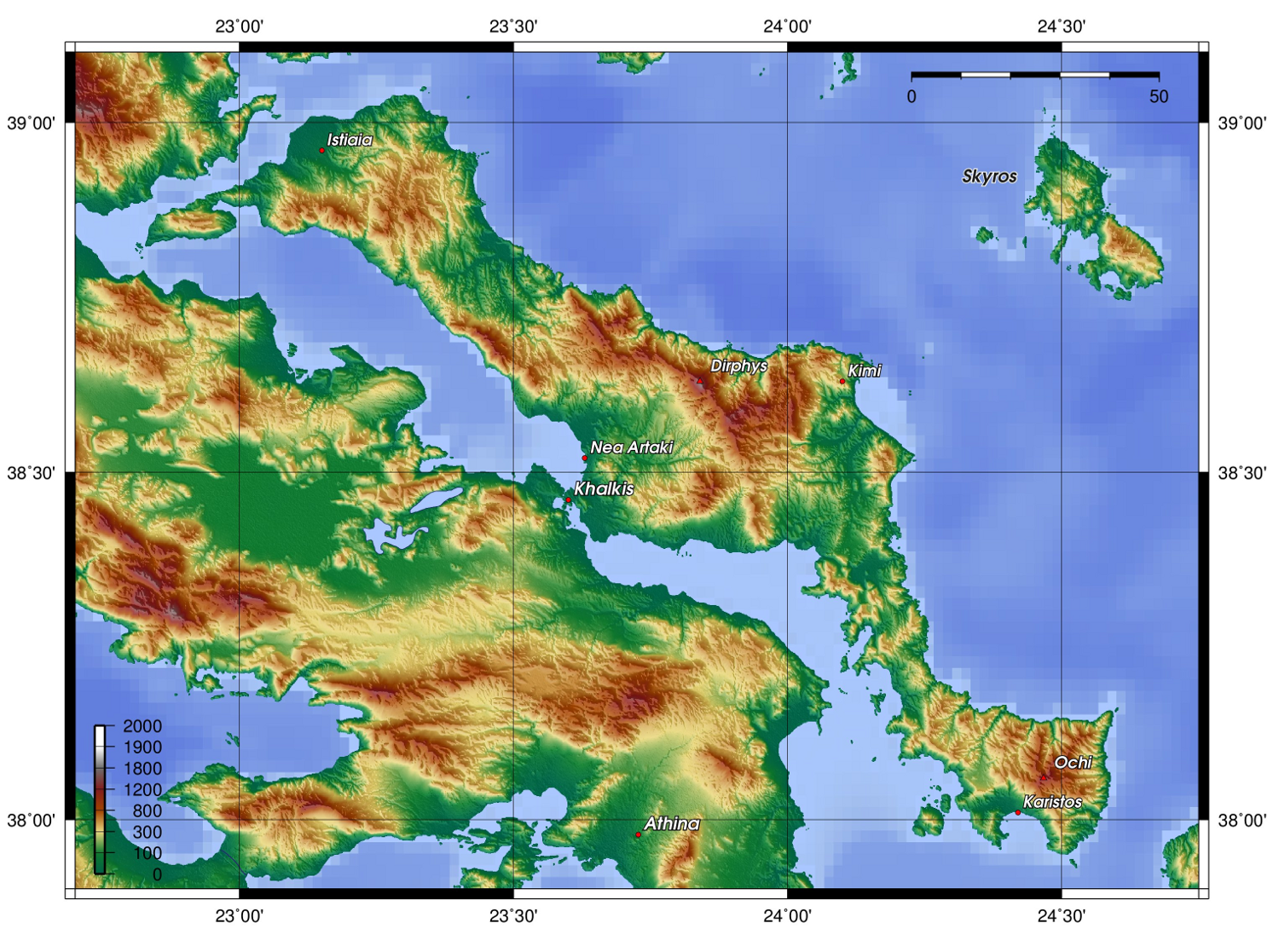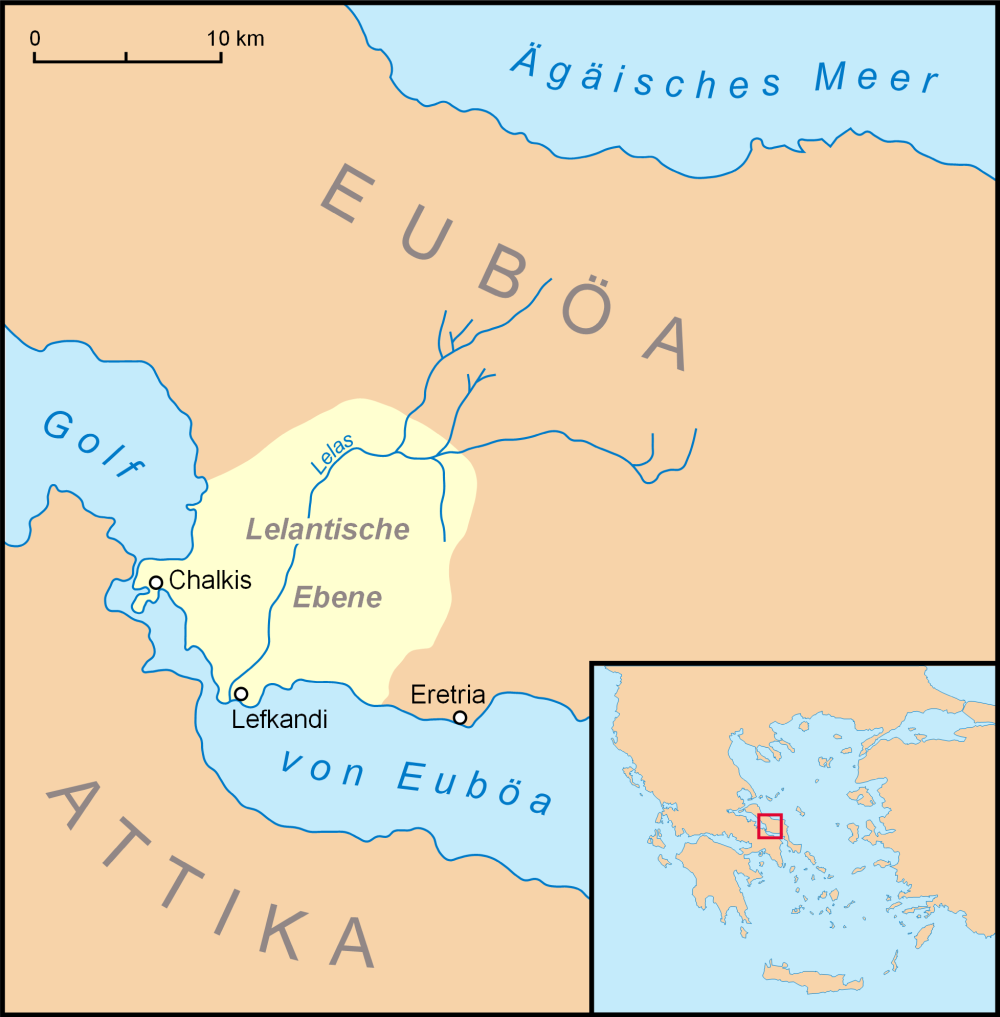|
Lefkandi
Lefkandi () is a coastal village on the island of Euboea, Greece. Archaeological finds attest to a settlement on the promontory locally known as Xeropolis, while several associated cemeteries have been identified nearby. The settlement site is located on a promontory overlooking the Euripos Strait, with small bays forming natural harbours east and west of the site. The cemeteries are located on the hillslopes northwest of the settlement; the plots identified so far are known as the East Cemetery, Skoubris, Palia Perivolia, Toumba, in addition to further smaller groups of burials. The site is located between the island's two main cities in antiquity, Chalkis and Eretria. Excavation here is conducted under the direction of the British School at Athens and is ongoing as of 2007 (previous campaigns in 1964–68, 1981–84). Occupation at Lefkandi can be traced back to the Early Bronze Age, and continued throughout the Bronze and Iron Ages, to end at the beginning of the Archaic period ... [...More Info...] [...Related Items...] OR: [Wikipedia] [Google] [Baidu] |
Greek Dark Ages
The term Greek Dark Ages refers to the period of Greek history from the end of the Mycenaean palatial civilization, around 1100 BC, to the beginning of the Archaic age, around 750 BC. Archaeological evidence shows a widespread collapse of Bronze Age civilization in the Eastern Mediterranean world at the outset of the period, as the great palaces and cities of the Mycenaeans were destroyed or abandoned. At about the same time, the Hittite civilization suffered serious disruption, as cities from Troy to Gaza were destroyed. In Egypt, the New Kingdom fell into disarray, which led to the Third Intermediate Period of Egypt. Following the collapse, fewer, smaller settlements suggest extensive famine and depopulation. In Greece, the Linear B script used by Mycenaean bureaucrats to write the Greek language ceased, with the Greek alphabet not developing until the beginning of the Archaic Period. The decoration on Greek pottery after about 1100 BC lacks the figurative d ... [...More Info...] [...Related Items...] OR: [Wikipedia] [Google] [Baidu] |
Evi Touloupa
Evi Touloupa (full name Paraskevi; née Stasinopoulou; Greek Έβη (Παρασκευή) Στασινοπούλου-Τουλούπα; 8 July 1924 - 10 October 2021) was a Greek archaeologist and Curator of Antiquities of the Acropolis. Early life and education Evi Stasinopoulou-Touloupa was born in Athens on July 8 1924; her full first name was Paraskevi, abbreviated to Evi by her mother. She attended primary school in the neighbourhood of Kypseli, where she lived with her parents, and then attended the German School of Athens from 1936-42: her father, an optician, chose this school because he travelled to Germany for work. She recalled later how, during the occupation of Greece in World War II, her father tried to withdraw her from the school to attend the free public school instead, but the director insisted that she continue to attend the German school for free. After high school, she enrolled in university but could not immediately attend due to the closure of universitie ... [...More Info...] [...Related Items...] OR: [Wikipedia] [Google] [Baidu] |
Argura (Euboea)
Argura ( grc, Ἄργουρα) also called Argyra (Ἀργυρᾶ) was a town of ancient Euboea near Chalkis, but its exact location is unknown. Modern scholars differ as to its location, with the current village of Lefkandi in the estuary of the Lilas River being identified by Denis Knoepfler Tritle places his remains on the hill of Vrachos in Vasiliko. The editors of the ''Barrington Atlas of the Greek and Roman World'' tentatively accept the Lefkandi location, as do the editors of the Digital Atlas of the Roman Empire (). Harpocration and Stephanus of Byzantium assert that the town had the status of a ''polis ''Polis'' (, ; grc-gre, πόλις, ), plural ''poleis'' (, , ), literally means "city" in Greek. In Ancient Greece, it originally referred to an administrative and religious city center, as distinct from the rest of the city. Later, it also ...,'' but Hansen and Nielsen have found no evidence supporting the assertion. References Populated places in ancient Eu ... [...More Info...] [...Related Items...] OR: [Wikipedia] [Google] [Baidu] |
Sub-Mycenaean Pottery
Submycenaean pottery is a style of ancient Greek pottery. It is transitional between the preceding Mycenaean pottery and the subsequent styles of Greek vase painting, especially the Protogeometric style. The vases date to between 1030 and 1000 BC. Submycenaean pottery is not very well researched, as only few sites from the period have been discovered so far. The style was first recognised in 1939 by Wilhelm Kraiker and Karl Kübler, based on finds from the Kerameikos and Pompeion cemeteries in Athens and on Salamis. The existence of the style remained disputed among archaeologists until later discoveries in Mycenae clearly showed the existence of separate Late Mycenaean and Submycenaean strata. Submycenaean pottery occurs primarily in contexts such as inhumations and stone-built cist graves. Find locations are widely distributed, suggesting a settlement pattern of hamlets and villages. Apart from the sites mentioned above, Submycenaean pottery is known from locations such as Cori ... [...More Info...] [...Related Items...] OR: [Wikipedia] [Google] [Baidu] |
Euboea
Evia (, ; el, Εύβοια ; grc, Εὔβοια ) or Euboia (, ) is the second-largest Greek island in area and population, after Crete. It is separated from Boeotia in mainland Greece by the narrow Euripus Strait (only at its narrowest point). In general outline it is a long and narrow island; it is about long, and varies in breadth from to . Its geographic orientation is from northwest to southeast, and it is traversed throughout its length by a mountain range, which forms part of the chain that bounds Thessaly on the east, and is continued south of Euboia in the lofty islands of Andros, Tinos and Mykonos. It forms most of the regional unit of Euboea, which also includes Skyros and a small area of the Greek mainland. Name Like most of the Greek islands, Euboea was known by other names in antiquity, such as ''Macris'' (Μάκρις) and ''Doliche'' (Δολίχη) from its elongated shape, or ''Ellopia'', ''Aonia'' and ''Abantis'' from the tribes inhabiting it. Its ancie ... [...More Info...] [...Related Items...] OR: [Wikipedia] [Google] [Baidu] |
Mitrou
The archaeological site of -Mitrou is located on a tidal islet in the Gulf of Atalanti, in East Lokris in Central Greece. Excavation of the site is conducted under the direction of the American School of Classical Studies, and as of 2007 is ongoing. Finds from surface survey indicate human presence already in the Neolithic period; occupation continues throughout the Bronze Age and into the Early Iron Age. In addition to the settlement, a Bronze Age boat and burials dating to the Bronze and Early Iron Ages have been found close to the settlement. Part of the site's importance derives from the apparently continuous habitation here after the end of the Mycenaean palatial Bronze Age, with no gap apparent between the post-palatial Bronze Age and the Early Iron Age. This situation is mirrored in other Central Greek sites, such as Lefkandi, Kalapodi, Elateia, and Pyrgos Livanaton/Kynos Cynus ( grc, Κῦνος, Kynos) was the principal sea-port of the Opuntian Locrians, situated on a ... [...More Info...] [...Related Items...] OR: [Wikipedia] [Google] [Baidu] |
Eretria
Eretria (; el, Ερέτρια, , grc, Ἐρέτρια, , literally 'city of the rowers') is a town in Euboea, Greece, facing the coast of Attica across the narrow South Euboean Gulf. It was an important Greek polis in the 6th and 5th century BC, mentioned by many famous writers and actively involved in significant historical events. Excavations of the ancient city began in the 1890s and have been conducted since 1964 by the Greek Archaeological Service (11th Ephorate of Antiquities) and the Swiss School of Archaeology in Greece. History of Eretria Prehistory The first evidence for human activity in the area of Eretria are pottery shards and stone artifacts from the late Neolithic period (3500–3000 BC) found on the Acropolis as well as in the plain. No permanent structures have yet been found. It is therefore unclear whether a permanent settlement existed at that time. The first known settlement from the Early Helladic period (3000–2000 BC) was located on the plain ... [...More Info...] [...Related Items...] OR: [Wikipedia] [Google] [Baidu] |
British School At Athens
, image = Image-Bsa athens library.jpg , image_size = 300px , image_upright= , alt= , caption = The library of the BSA , latin_name= , motto= , founder = The Prince of Wales, later Edward VII, called the foundation meeting in 1883 , established = 1886, the year the completed building was opened for business, and the tenancy of the first Director began , mission = "to promote the study of Greece in all its aspects." , focus = "to provide facilities for those engaged in research into anthropology, archaeology, archaeometry, architecture, art, environment, geography, history, language, literature, religion and topography pertaining to Greek lands in all periods including modern times." , president= , chairman = Roderick Beaton , head_label = Director , head = John Bennet , faculty = , adjunct_faculty= , staff= , key_people= , budget= , endowment = £2,242,453 in mid-2018 , debt= , num_members= , subsidiaries = F ... [...More Info...] [...Related Items...] OR: [Wikipedia] [Google] [Baidu] |
Architecture
Architecture is the art and technique of designing and building, as distinguished from the skills associated with construction. It is both the process and the product of sketching, conceiving, planning, designing, and constructing buildings or other structures. The term comes ; ; . Architectural works, in the material form of buildings, are often perceived as cultural symbols and as works of art. Historical civilizations are often identified with their surviving architectural achievements. The practice, which began in the prehistoric era, has been used as a way of expressing culture for civilizations on all seven continents. For this reason, architecture is considered to be a form of art. Texts on architecture have been written since ancient times. The earliest surviving text on architectural theories is the 1st century AD treatise '' De architectura'' by the Roman architect Vitruvius, according to whom a good building embodies , and (durability, utility, and beauty). ... [...More Info...] [...Related Items...] OR: [Wikipedia] [Google] [Baidu] |
Linen
Linen () is a textile made from the fibers of the flax plant. Linen is very strong, absorbent, and dries faster than cotton. Because of these properties, linen is comfortable to wear in hot weather and is valued for use in garments. It also has other distinctive characteristics, notably its tendency to wrinkle. Linen textiles appear to be some of the oldest in the world; their history goes back many thousands of years. Dyed flax fibers found in a cave in Southeastern Europe (present-day Georgia) suggest the use of woven linen fabrics from wild flax may date back over 30,000 years. Linen was used in ancient civilizations including Mesopotamia and ancient Egypt, and linen is mentioned in the Bible. In the 18th century and beyond, the linen industry was important in the economies of several countries in Europe as well as the American colonies. Textiles in a linen weave texture, even when made of cotton, hemp, or other non-flax fibers, are also loosely referred to as "linen". ... [...More Info...] [...Related Items...] OR: [Wikipedia] [Google] [Baidu] |




